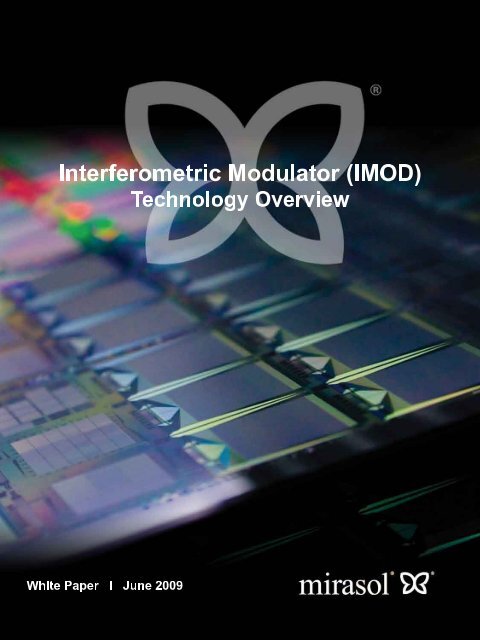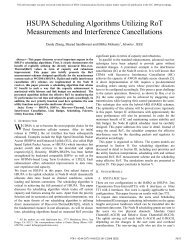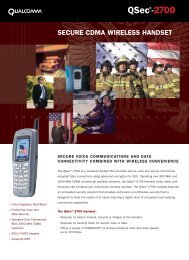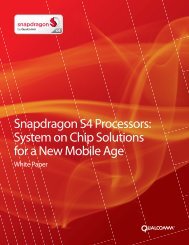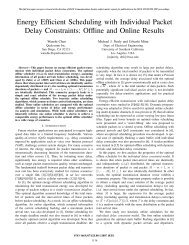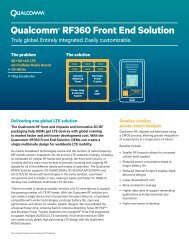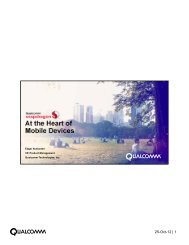Read all about the benefits of mirasol displays - Qualcomm
Read all about the benefits of mirasol displays - Qualcomm
Read all about the benefits of mirasol displays - Qualcomm
Create successful ePaper yourself
Turn your PDF publications into a flip-book with our unique Google optimized e-Paper software.
Table <strong>of</strong> ContentsExecutive Summary…………..……………………………………………………………………… 1Overview <strong>of</strong> Portable Display Technologies……………………………………………………… 2Emissive/Transmissive Displays………………………………………………………… 2Reflective Displays (Continuous refresh type)………………………………………… 2Reflective Displays (Bistable type)…………………………………… ………………… 3Transflective Displays..…………………………………………………………………… 3Overview <strong>of</strong> IMOD Technology…………………………………………………………………… 4How It Works…………..……………………………………………………………………………… 4Color Generation…..…….………………………………………………………………… 4Grayscale Generation…………..………………………………………………………… 6Bistability…………..…..…………………………………………………………………… 7Additional Key Attributes…………..………………………………………………………………… 9Speed…………..…………………………………………………………………………… 9<strong>Read</strong>ability…………..……………………………………………………………………… 9Ease <strong>of</strong> Manufacture….…………………………………………………………………... 11Robustness…………..…………………………………..………………………………... 11Industry Compatibility……..….…………………………………………………………... 11Page i
Executive SummaryToday’s cell phones are a far cry from <strong>the</strong> devices <strong>of</strong> 20—or even 5—years ago. Gone are <strong>the</strong>days <strong>of</strong> carrying a separate camera, phone, music player and PDA—today’s “smartphones”incorporate each <strong>of</strong> <strong>the</strong>se functions into one multipurpose device. As computer technologyand multimedia converge in <strong>the</strong> mobile phone, <strong>the</strong> industry has witnessed a dramatic changein how consumers view <strong>the</strong>ir wireless devices. Today’s cell phone is an indispensable tool,bringing users information and entertainment. But as cell phones’ functionality increases andconsumers use <strong>the</strong>m for more than just making and receiving c<strong>all</strong>s, consumers are demandingmore from <strong>the</strong>ir mobile phones—including extended battery life and superior viewability in <strong>all</strong>environmental conditions—in short, a convergent cell phone. The key to such improvements is<strong>the</strong> display. Today’s liquid-crystal <strong>displays</strong> (LCDs) consume significant power, suffer from poorviewability in direct sunlight and do not <strong>of</strong>fer convergent capabilities, but a revolutionary newdisplay technology makes <strong>all</strong> <strong>of</strong> this possible. The <strong>mirasol</strong> ® <strong>displays</strong> by <strong>Qualcomm</strong> ® , based onmicro-electro-mechanical system (MEMS) based Interferometric Modulation (IMOD)technology, <strong>of</strong>fer users a convergent display experience, with paper-like readability in almostany ambient condition, while consuming significantly less power than any o<strong>the</strong>r displayavailable today. In addition, <strong>mirasol</strong> <strong>displays</strong> <strong>of</strong>fer features such as industry-standard interfacecompatibility, manufacturability in existing Flat-Panel Display (FPD) fabs, fast response speedand wide operating range <strong>all</strong> in a mechanic<strong>all</strong>y rugged package—making <strong>mirasol</strong> <strong>displays</strong> <strong>the</strong>best display solution for today’s convergent wireless devices.Page 1
Overview <strong>of</strong> Portable Display TechnologiesInk and paper are arguably <strong>the</strong> de facto standard for information display. Developed over 5,000years ago, today’s inks and dyes provide lifelike color imagery. Display technologies, on <strong>the</strong>o<strong>the</strong>r hand, are relatively new. The CRT was developed less than 100 years ago and <strong>the</strong>increasingly popular flat-panel display less than 40 years ago. For roughly a decade now,engineers have been working to create a display technology capable <strong>of</strong> providing a paper-likereading experience, not only with regards to superior viewability, but also with respect to cost,power and ease <strong>of</strong> manufacture. Display technologies such as backlit LCDs, reflective LCDs,electroluminescent (EL) <strong>displays</strong>, organic light-emitting diodes (OLED) and electrophoretic<strong>displays</strong> (EPD) were <strong>all</strong> steps in this direction. <strong>mirasol</strong> <strong>displays</strong>, based on industry-provenMEMS technology, promise to take <strong>the</strong> quest for paper-like <strong>displays</strong> to a new level.A wide variety <strong>of</strong> display technologies are aiming to capture <strong>the</strong> key characteristics <strong>of</strong> ink andpaper. In this section we will compare <strong>the</strong>m, with particular emphasis on energy consumptionand readability.Emissive/Transmissive DisplaysDisplays are classified as one <strong>of</strong> three types: emissive/transmissive, reflective or transflective.A transmissive LCD consists <strong>of</strong> two transmissive substrates between which <strong>the</strong> liquid-crystalmaterial resides. By placing a backlight underneath one <strong>of</strong> <strong>the</strong> substrates and by applying avoltage to <strong>the</strong> liquid-crystal material <strong>the</strong> light reaching <strong>the</strong> observer can be modulated so as tomake <strong>the</strong> display pixel appear bright or dark. A display can also directly emit light, as in <strong>the</strong>case <strong>of</strong> an OLED display, whose active display material emits light. In <strong>the</strong> case <strong>of</strong> an LCD, aconstant source <strong>of</strong> power is required to both modulate <strong>the</strong> liquid-crystal material and to power<strong>the</strong> backlight. An LCD requires constant refreshing—at least sixty times per second—in orderto prevent <strong>the</strong> liquid-crystal material from transitioning to a different modulation state, resultingin image degradation or flicker. Such is also <strong>the</strong> case with OLED and EPD—constant powermust be provided to <strong>the</strong> light-emitting materials in order to prevent screen flicker.Reflective Displays (Continuous refresh type)In a reflective display, one <strong>of</strong> <strong>the</strong> substrates found in a transmissive display is replaced with areflective substrate. Reflective <strong>displays</strong> usu<strong>all</strong>y employ liquid-crystal material on top <strong>of</strong> <strong>the</strong>reflective substrate so as to modulate <strong>the</strong> ambient light reflecting <strong>of</strong>f <strong>the</strong> reflective substrate.Since <strong>the</strong>re is no backlight in reflective <strong>displays</strong>, <strong>the</strong>y consume substanti<strong>all</strong>y less power thanemissive <strong>displays</strong>. However, since <strong>the</strong> material providing modulation is liquid-crystal, <strong>the</strong>majority <strong>of</strong> <strong>the</strong>se types <strong>of</strong> <strong>displays</strong> must constantly be refreshed or <strong>the</strong> displayed image will belost. So far, most portable devices employing reflective <strong>displays</strong> are <strong>the</strong> continuous refreshtype.Page 2
Reflective Displays (Bistable type)A bistable display is capable <strong>of</strong> maintaining one <strong>of</strong> two states (on or <strong>of</strong>f) without any externalinfluence such as an electric field. A bistable reflective display employing liquid-crystalmaterial for light modulation is in many ways identical to <strong>the</strong> continuous-refresh reflectivedisplay. The key difference is <strong>the</strong> type <strong>of</strong> liquid-crystal material that is used. Through properchoice <strong>of</strong> chemistry, manufacturing and drive schemes, <strong>the</strong> liquid-crystal material can belocked into one <strong>of</strong> two states. Once <strong>the</strong> material has been locked into a certain configuration, itis not necessary for <strong>the</strong> display to be refreshed. In fact, power can be completely removedfrom <strong>the</strong> system and <strong>the</strong> display will maintain <strong>the</strong> last image shown.EPD and <strong>mirasol</strong> <strong>displays</strong> are also bistable. EPDs typic<strong>all</strong>y consist <strong>of</strong> charged microcapsulescontaining dye suspended between two substrates. The microcapsule, gener<strong>all</strong>y a sphere, isblack on one half and white on <strong>the</strong> o<strong>the</strong>r. Depending on <strong>the</strong> electric field applied between <strong>the</strong>two substrates, <strong>the</strong> microcapsule will flip orientation to position ei<strong>the</strong>r <strong>the</strong> black or <strong>the</strong> white halftoward <strong>the</strong> observer. Depending on <strong>the</strong> capsule orientation, <strong>the</strong> ambient light will ei<strong>the</strong>r bereflected toward <strong>the</strong> observer or be absorbed.In a <strong>mirasol</strong> display, a flexible thin-film mirror is fabricated on a transparent substrate, leavingan air gap <strong>of</strong> a few hundred nanometers between <strong>the</strong> thin film and <strong>the</strong> substrate such thatwhen ambient light enters this cavity and reflects <strong>of</strong>f <strong>the</strong> thin-film mirror, it interferes with itself,producing a resonant color determined by <strong>the</strong> height <strong>of</strong> <strong>the</strong> cavity. A <strong>mirasol</strong> display producesiridescent color, similar to what you would observe in a butterfly’s wings. Depending on <strong>the</strong>electric field applied between <strong>the</strong> substrate and <strong>the</strong> thin film, <strong>the</strong> film can be positioned in one<strong>of</strong> two states. Because <strong>mirasol</strong> <strong>displays</strong> are bistable, <strong>the</strong>y don’t require a refresh until <strong>the</strong>image is changed. As a result, <strong>the</strong>y consume very little power, providing extended battery lifefor <strong>the</strong> user.Transflective DisplaysTransflective <strong>displays</strong> are a hybrid <strong>of</strong> emissive and reflective display technologies.Transflective <strong>displays</strong> were engineered to overcome <strong>the</strong> shortcomings <strong>of</strong> emissive <strong>displays</strong>,namely <strong>the</strong> backlight’s high power consumption, and <strong>the</strong> shortcomings <strong>of</strong> reflective <strong>displays</strong>,such as poor image quality at low ambient light levels. Transflective <strong>displays</strong> employ a parti<strong>all</strong>ytransmissive mirror as <strong>the</strong> secondary substrate, as well as a traditional backlight. In low lightsituations, <strong>the</strong> device operates as a transmissive display, employing <strong>the</strong> backlight. In highambient light conditions, <strong>the</strong> backlight turns <strong>of</strong>f and <strong>the</strong> display functions as a reflective display.A transflective display is a compromise and its image quality is gener<strong>all</strong>y subpar. In sunlight<strong>the</strong>y are not as bright as purely reflective <strong>displays</strong>, while indoors <strong>the</strong>y are not as bright asemissive <strong>displays</strong>. Regardless, <strong>the</strong>y <strong>of</strong>fer a compromise for applications where a wide variety<strong>of</strong> lighting conditions are seen and transflective <strong>displays</strong> are widely used in <strong>the</strong> portable devicemarket.Page 3
Overview <strong>of</strong> IMOD Technology in <strong>mirasol</strong> DisplaysMEMS-based display technologies have been under development for over a decade, but haveonly recently started to gain traction. Display systems based on arrays <strong>of</strong> movable mirrors arenow widely available in <strong>the</strong> consumer marketplace. Deformable mirrors and mechanicalshutters are also making use <strong>of</strong> MEMS-based <strong>displays</strong>. Their digital nature and fast responsemake <strong>the</strong>m ideal for display applications. However, <strong>the</strong>ir role has been limited to applicationswith fixed-angle light sources ra<strong>the</strong>r than portable direct-view <strong>displays</strong>, as <strong>the</strong>y are not effectivewhen removed from a fixed-angle light source.Developed to address <strong>the</strong>se shortcomings, <strong>mirasol</strong> <strong>displays</strong> are based on <strong>the</strong> principle <strong>of</strong>interference, which is used to determine <strong>the</strong> color <strong>of</strong> <strong>the</strong> reflected light. IMOD pixels arecapable <strong>of</strong> switching speeds on <strong>the</strong> order <strong>of</strong> 10 microseconds. Addition<strong>all</strong>y, <strong>mirasol</strong> <strong>displays</strong>fabricated to use IMOD technology have shown reflectivities <strong>of</strong> greater than 60 percent,contrast ratios greater than 15:1 and drive voltages <strong>of</strong> as low as 5 volts. Though simple instructure, IMOD elements provide <strong>the</strong> functions <strong>of</strong> modulation, color selection and memorywhile eliminating active matrices, color filters and polarizers. The result is a high-performancedisplay capable <strong>of</strong> active-matrix type functionality at passive-matrix cost. <strong>Qualcomm</strong>’s <strong>mirasol</strong><strong>displays</strong> are a strong contender in <strong>the</strong> display industry, with <strong>the</strong> potential to <strong>of</strong>fer many <strong>of</strong> <strong>the</strong><strong>benefits</strong> <strong>of</strong> ink and paper.How It WorksColor GenerationAt <strong>the</strong> most basic level, a <strong>mirasol</strong> display is an optic<strong>all</strong>y resonant cavity similar to a Fabry-Perotetalon. The device consists <strong>of</strong> a self-supporting deformable reflective membrane and a thin-filmstack (each <strong>of</strong> which acts as one mirror <strong>of</strong> an optic<strong>all</strong>y resonant cavity), both residing on atransparent substrate.When ambient light hits <strong>the</strong> structure, it is reflected both <strong>of</strong>f <strong>the</strong> top <strong>of</strong> <strong>the</strong> thin-film stack and <strong>of</strong>f<strong>the</strong> reflective membrane. Depending on <strong>the</strong> height <strong>of</strong> <strong>the</strong> optical cavity, light <strong>of</strong> certainwavelengths reflecting <strong>of</strong>f <strong>the</strong> membrane will be slightly out <strong>of</strong> phase with <strong>the</strong> light reflecting <strong>of</strong>f<strong>the</strong> thin-film structure. Based on <strong>the</strong> phase difference, some wavelengths will constructivelyinterfere, while o<strong>the</strong>rs will destructively interfere as shown in Figure 1. As illustrated, <strong>the</strong> redwavelengths have a phase difference which leads to constructive interference, while <strong>the</strong> greenand blue wavelengths have a phase difference which leads to destructive interference. As aresult, <strong>the</strong> human eye will perceive a red color, as certain wavelengths will be amplified withrespect to o<strong>the</strong>rs. Color generation via interference is much more efficient in its use <strong>of</strong> lightcompared to traditional color filters and polarizers, which work on <strong>the</strong> principle <strong>of</strong> absorptionand waste much <strong>of</strong> <strong>the</strong> light entering <strong>the</strong> display.Page 4
Figure 1. IMOD Structure Showing Light Reflecting <strong>of</strong>f <strong>the</strong> Thin-film Stack and Mirror Interferingto Produce ColorThe image on a <strong>mirasol</strong> display can switch between color and black by changing <strong>the</strong>membrane state. This is accomplished by applying a voltage to <strong>the</strong> thin-film stack, which iselectric<strong>all</strong>y conducting and is protected by an insulating layer. When a voltage is applied,electrostatic forces cause <strong>the</strong> membrane to collapse. The change in <strong>the</strong> optical cavity nowresults in constructive interference at ultraviolet wavelengths, which are not visible to <strong>the</strong>human eye. Hence, <strong>the</strong> image on <strong>the</strong> screen appears black.A full-color display is assembled by spati<strong>all</strong>y ordering IMOD elements reflecting in <strong>the</strong> red,green and blue wavelengths as shown in Figure 1.Page 5
Grayscale GenerationAt <strong>the</strong> most basic level, <strong>the</strong> IMOD element is a 1 bit device, that is, it can be driven to ei<strong>the</strong>r adark (black) or bright (color) state. In order to be able to show grayscale images, spatial ortemporal di<strong>the</strong>ring can be used.Spatial di<strong>the</strong>ring divides a given subpixel into many sm<strong>all</strong>er addressable elements, and drives<strong>the</strong> individual elements separately in order to obtain <strong>the</strong> gray levels. Such a scheme requiresan additional row driver per element. In Figure 2 a binary weighted spatial di<strong>the</strong>ring scheme isshown which produces 8 gray shades per color, for a total <strong>of</strong> 512 colors.Figure 2. Grayscale Generation in a PixelAlternatively, temporal di<strong>the</strong>ring can be used to obtain additional gray shades. Temporaldi<strong>the</strong>ring works by splitting each field <strong>of</strong> data into, for example, two fields, where one subfieldlasts 8 times longer than <strong>the</strong> o<strong>the</strong>r. As shown in Figure 3, <strong>the</strong> subpixel elements are areaweighted in ratios <strong>of</strong> 1:2:4. In order to achieve 64 gray levels per color for a total <strong>of</strong> 256K colors,this area ratio is combined with <strong>the</strong> subfield timing (area <strong>of</strong> subpixel elements x temporalsubfield) to give a ratio <strong>of</strong> 1:2:4:8:16:32. Cycling <strong>the</strong> frames at >50Hz <strong>all</strong>ows <strong>the</strong> eye to timeintegrate <strong>the</strong> subfields and perceive <strong>the</strong> large number <strong>of</strong> gray shades.Page 6
Figure 3. Grayscale Generation Via Temporal Di<strong>the</strong>ringBoth spatial and temporal di<strong>the</strong>ring have <strong>the</strong>ir pros and cons. Spatial di<strong>the</strong>ring <strong>of</strong>fers lowerpower consumption as <strong>the</strong> display does not need to be refreshed as <strong>of</strong>ten as when temporaldi<strong>the</strong>ring is used. Since power consumption is proportional to <strong>the</strong> display refresh frequency,temporal di<strong>the</strong>ring is best used in cases where power is <strong>of</strong> less concern. Temporal di<strong>the</strong>ring,however, <strong>of</strong>fers a lower cost display since fewer IMOD elements are addressed and provides ahigher fill factor. Fin<strong>all</strong>y, a combination <strong>of</strong> both temporal and spatial di<strong>the</strong>ring can also be usedto increase <strong>the</strong> number <strong>of</strong> gray levels; such a scheme could balance <strong>the</strong> opticalefficiency/power trade<strong>of</strong>f.BistabilityOne <strong>of</strong> <strong>the</strong> key advantages <strong>of</strong> <strong>the</strong> <strong>mirasol</strong> display’s design is its bistable nature, which <strong>all</strong>owsfor near-zero power usage in situations where <strong>the</strong> display image is unchanged. This meansthat <strong>mirasol</strong> <strong>displays</strong> benefit from considerable power savings, especi<strong>all</strong>y compared to <strong>displays</strong>that continu<strong>all</strong>y refresh, such as LCDs. The bistability <strong>of</strong> <strong>mirasol</strong> <strong>displays</strong> comes from <strong>the</strong>inherent hysteresis derived from <strong>the</strong> technology’s electro-mechanical properties. Morespecific<strong>all</strong>y, it derives from an inherent imbalance between <strong>the</strong> linear restorative forces <strong>of</strong> <strong>the</strong>mechanical membrane and <strong>the</strong> non-linear forces <strong>of</strong> <strong>the</strong> applied electric field. As shown in Figure 4,<strong>the</strong> resulting electro-opto-mechanical behavior is hysteretic in nature and provides a built-in“memory” effect similar to <strong>the</strong> thin-film transistor (TFT) element in an active-matrix display.Page 7
Additional Key AttributesSpeedSince visible light wavelengths operate on <strong>the</strong> nanometer scale (i.e., 380nm to 780nm), <strong>the</strong>deformable IMOD membrane only has to move a short distance—a few hundred nanometers—in order to switch between two colors. This switching happens extremely fast, on <strong>the</strong> order <strong>of</strong>tens <strong>of</strong> microseconds. This switching speed directly translates to a video rate-capable displaywith no motion-blur effects. Traditional STN- or cholesteric-based passive matrix <strong>displays</strong> haveswitching speeds as slow as tens or hundreds <strong>of</strong> milliseconds. An IMOD element’s switchingtime is 1000 times faster than traditional <strong>displays</strong>. In addition, switching speed <strong>of</strong> <strong>mirasol</strong><strong>displays</strong> is maintained across a wide temperature range, unlike organic liquid-crystal-based<strong>displays</strong>, whose switching speeds decrease as temperatures go into low environmental ranges.<strong>Read</strong>abilityHumans view <strong>the</strong> world by sensing <strong>the</strong> light reflecting from various surfaces. As a result, areflected image from a newspaper is more appealing and easier to view for <strong>the</strong> human eye,compared to a backlit image. Based on human perception, <strong>the</strong>re are two critical factors whichdetermine readability: luminance and contrast.Luminance is <strong>the</strong> amount <strong>of</strong> light that reaches <strong>the</strong> human eye. In <strong>the</strong> case <strong>of</strong> a reflective display,it is <strong>the</strong> amount <strong>of</strong> ambient light that is reflected from <strong>the</strong> display, ra<strong>the</strong>r than absorbed. The keymetric is <strong>the</strong> reflectivity <strong>of</strong> <strong>the</strong> display’s white state, which is measured by comparing it to <strong>the</strong>reflectivity <strong>of</strong> a standard white source. A white sheet <strong>of</strong> paper measures between 70 and 90percent reflectivity, and a newspaper measures on <strong>the</strong> order <strong>of</strong> 60 percent reflectivity.Contrast is <strong>the</strong> ratio <strong>of</strong> <strong>the</strong> display’s white state reflectivity to its dark state. This metric dictateswhe<strong>the</strong>r or not <strong>the</strong> human eye will be able to perceive transitions between <strong>the</strong> dark and lightareas on <strong>the</strong> display, which translates to spatial detail. If <strong>the</strong> contrast is too low, <strong>the</strong> display willappear washed out and <strong>the</strong> user will have difficulty perceiving image details. A high contrastratio makes <strong>the</strong> image look sharper and improves readability. For reference, a newspaper has acontrast ratio <strong>of</strong> approximately 4:1.Comparing <strong>the</strong> readability <strong>of</strong> reflective <strong>displays</strong> to that <strong>of</strong> emissive <strong>displays</strong>, it is clear thatemissive <strong>displays</strong> work well at low ambient light levels. The problem with <strong>the</strong>se <strong>displays</strong>,however, is when ambient light levels increase from room lighting to levels found outdoors on asunny day, making it difficult for <strong>the</strong> user to discern spatial detail as shown in Figure 5. This isillustrated by <strong>the</strong> fact that a user must typic<strong>all</strong>y shield <strong>the</strong>ir portable-device screen when <strong>the</strong>yare outdoors in bright sunlight. Two factors account for this: first, <strong>the</strong> increase in light that isreflected from <strong>the</strong> device pixel in <strong>the</strong> black state and second, <strong>the</strong> ambient light exceeding <strong>the</strong>light levels being emitted from <strong>the</strong> display. Both <strong>of</strong> <strong>the</strong>se factors reduce <strong>the</strong> display’s contrast.Page 9
Figure 5. Brightness/Contrast Versus Ambient Light LevelsIn <strong>the</strong> case <strong>of</strong> reflective <strong>displays</strong>, <strong>the</strong> black state suffers from <strong>the</strong> same problem as emissive<strong>displays</strong>—<strong>the</strong> black-level luminance increases as ambient light levels increase. However, <strong>the</strong>display’s white state <strong>of</strong>fers superior viewability. As ambient light levels increase, so does <strong>the</strong><strong>mirasol</strong> display’s white-state reflectivity. As a result, a <strong>mirasol</strong> display <strong>of</strong>fers a superior contrastratio in brightly lit environments. In darker environments, supplemental illumination is providedby a low-power frontlight.An additional benefit <strong>of</strong> <strong>mirasol</strong> <strong>displays</strong> is <strong>the</strong>ir wide viewing angle. Unlike an LCD display,which exhibits grayscale inversion when viewed at angles varying in elevation from normal(looking directly at <strong>the</strong> display, head-on), <strong>the</strong> <strong>mirasol</strong> display shows a non-grayscale-invertedimage. Images shown on <strong>mirasol</strong> <strong>displays</strong> are also impervious to rotations around <strong>the</strong> normal,once again unlike LCD-based <strong>displays</strong>. In this sense, <strong>the</strong> IMOD element provides <strong>the</strong> benefit <strong>of</strong>an emissive—a wide symmetrical viewing angle.<strong>Qualcomm</strong>’s <strong>mirasol</strong> <strong>displays</strong> <strong>of</strong>fer reflectivity on <strong>the</strong> order <strong>of</strong> 50 percent and contrast ratiosgreater than 8:1. By comparison, <strong>the</strong> W<strong>all</strong> Street Journal newspaper <strong>of</strong>fers a reflectivity <strong>of</strong> 60percent and a contrast ratio <strong>of</strong> around 4:1.Page 10
Ease <strong>of</strong> ManufactureThe MEMS elements that constitute a <strong>mirasol</strong> display have been designed for ease <strong>of</strong>manufacture. <strong>Qualcomm</strong>’s <strong>mirasol</strong> <strong>displays</strong> are produced using a process known as surfacemicro- machining, which is derived from <strong>the</strong> wafer scale roots <strong>of</strong> MEMS fabrication. The namerefers to <strong>the</strong> idea <strong>of</strong> building <strong>all</strong> <strong>of</strong> <strong>the</strong> structure and components <strong>of</strong> <strong>the</strong> MEMS device on <strong>the</strong>surface <strong>of</strong> <strong>the</strong> underlying substrate. In <strong>the</strong> case <strong>of</strong> <strong>mirasol</strong> <strong>displays</strong>, <strong>the</strong>se comprise an array <strong>of</strong>deposited metal and metal-oxide films which are lithographic<strong>all</strong>y patterned to produce amicroscopic planar structure. The result is a monolithic electro-optic display which requiresfewer process steps to build than <strong>the</strong> TFT array in a LCD.The overarching manufacturing benefit <strong>of</strong> <strong>mirasol</strong> display production is that <strong>the</strong> process wasengineered to utilize infrastructure already in place in FPD fabs. All <strong>of</strong> <strong>the</strong> materials used for<strong>mirasol</strong> display fabrication currently exist within <strong>the</strong> FPD palette and, in most cases, substitutematerials may be utilized. The end result is a flexible and robust process that enablesconversion, with minimal modification, <strong>of</strong> many FPD fabs into <strong>mirasol</strong> display foundries,minimizing <strong>the</strong> time needed to bring IMOD technology to market.RobustnessThe biggest problem with LCD lifetime is <strong>the</strong> use <strong>of</strong> organic materials. Both <strong>the</strong> liquid-crystalmaterial and <strong>the</strong> alignment material are organic and, as a result, break down over time whenexposed to high temperature and light (both artificial and sunlight.) By relying on inorganicmaterials, <strong>mirasol</strong> <strong>displays</strong> are capable <strong>of</strong> performing over an extended temperature range andat <strong>the</strong> same time are impervious to high-intensity visible and UV radiation. Addition<strong>all</strong>y, evenwhen exposed to extreme temperatures, a <strong>mirasol</strong> display’s response times are unaffected,and <strong>the</strong> impact on drive voltages and image content is minimal.Mechanic<strong>all</strong>y, <strong>the</strong> IMOD element is extremely robust. <strong>mirasol</strong> <strong>displays</strong> have demonstratedreliability over 12 billion cycles.Industry Compatibility<strong>Qualcomm</strong>’s <strong>mirasol</strong> display are designed to conform to industry standards, enabling <strong>mirasol</strong>modules to be “plug-and-play” compatible with standard mobile systems. The <strong>mirasol</strong> module<strong>of</strong>fers standard industry interfaces, and standard power supplies. This use <strong>of</strong> industrystandards ensures that <strong>the</strong>re is minimal risk to adopting this powerful new technology ensuresthat <strong>the</strong>re is minimal risk to adopting this powerful new technology will <strong>all</strong>ow for vastly improvedperformance and highly differentiated products to end users.Page 11
© 2009 <strong>Qualcomm</strong> MEMS Technologies, Inc. All rights reserved. <strong>Qualcomm</strong> is a registered trademark <strong>of</strong> <strong>Qualcomm</strong>Incorporated. The butterfly symbol and <strong>mirasol</strong> are registered trademarks <strong>of</strong> <strong>Qualcomm</strong> MEMS Technologies, Inc. Certaino<strong>the</strong>r product names, brand names and company names mentioned in this document may be trademarks <strong>of</strong> <strong>the</strong>irrespective owners. Data subject to change without notice. 061/09www.<strong>mirasol</strong><strong>displays</strong>.com


